This time last year, the Irish Farmers Journal commissioned KPMG to do an Economic Impact Assessment on Agriculture for a range of emissions reduction targets by 2030.
Encouragingly, it found that the Irish agricultural sector could deliver up to 18% in reductions without any reduction in cattle numbers.
The measures required to deliver an 18% reduction would have an added benefit of increasing profitability on the average dairy farm by €2,150 though with a loss of €300 for the average beef farm.
Anything above 18% requires a cut in livestock numbers with consequent effect on rural employment and the wider rural economy.
Two scenarios
KPMG modelled two scenarios at either end of the range identified by the Government and the higher the emissions reduction from agriculture, the greater the economic impact.
Delivering a 21% reduction
Even if the Government settles on the lowest point in the range, it will still come at a big cost to Irish farmers and the wider rural economy.
In addition to farmers undertaking all the measures required to deliver the 18% reduction in emissions, it would require a 6% cut to the beef cattle herd and 5% cut to the dairy cattle herd to increase the reduction of emissions by a further 3% to 21% overall.
To meet the Government’s lowest point in the range for agriculture, 22%, it would require a higher cut in cattle numbers again.
KPMG assessed that the economic impact of what might seem a relatively small cut in cattle numbers would still be dramatic.
A 5% reduction in cattle numbers on the average dairy farm would mean a drop in income of €9,900, which would translate into an average profit loss of €4,300 when reduced input costs are factored in.
For the average beef farm, a drop in cattle numbers of 6% would cause an income reduction of €1,400 translating to an average profit loss of €1,200 per farm when the €200 reduction in input costs is factored in.
The economic cost isn’t confined to farmers.
As the produce from Irish farms is processed locally with up to 90% of production sold in international markets, there is a wider economic impact.
KPMG calculated that this would mean a loss of 10,000 jobs, and a €1.1bn hit to the rural economy between on-farm and off-farm losses.
Delivering a 30% reduction
KPMG calculated that a requirement on agriculture to deliver a 30% reduction in emissions by 2030 could only be achieved through a major reduction in livestock numbers.
Even with farmers taking all the steps available with current knowledge and delivering an 18% reduction in emissions, increasing this target to 30% would mean a reduction of 22% in the beef herd, 18% in the dairy herd and 5% across pigs, poultry and sheep.
This would mean a drop of €35,500 in revenue on dairy farms, which would equate to a €17,500 or a 25% drop in dairy farm profits when the reduced input costs (mainly feed and fertiliser) are factored in.
It is a similar trend on beef farms, with overall revenue falling by €5,200 because of less numbers which translates to a reduction in farm profit of €2,800 when input costs are included.
At this level of herd reduction, the overall on-farm loss of economic output was put at €2.1bn by KPMG.
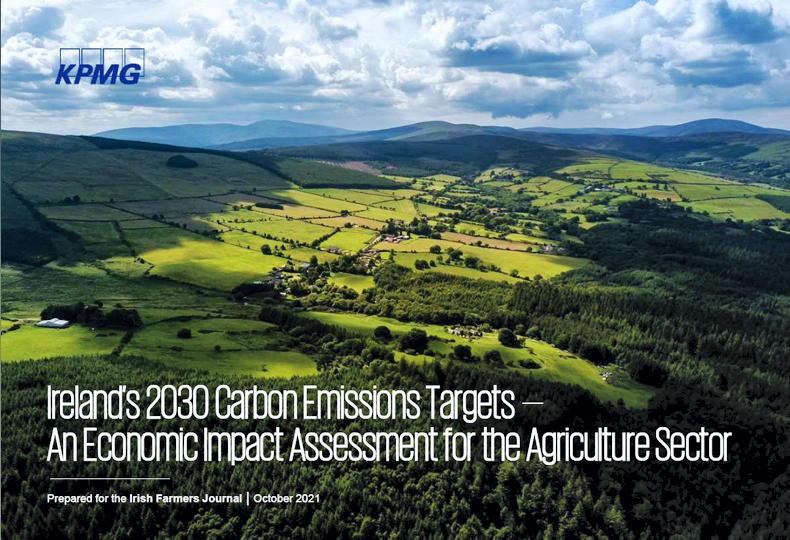
KPMG report cover.
When this is added to the economic loss from processing and the wider supply chain, it makes the total combined loss from a 30% reductions €3.9bn.
Dramatic
Even more dramatic is the impact on employment with KPMG calculating that achieving the 30% target would mean a loss of 56,400 jobs.
Given that dairy and meat processing businesses are located across the entire country, often in less well-known areas, this would be catastrophic.
The KPMG report also produced an option that could achieve an 18% reduction in emissions from agriculture with minimal negative economic impact on beef and, in the case of dairy, an economic benefit.
This would be achieved through adoption by farmers of measures identified by the Teagasc Marginal Abatement Cost Curve (MACC) such as breeding efficiency, low-emissions slurry spreading, use of protected urea fertiliser and feed additives being the most prominent.
Even though it is outside the Government’s 22% to 30% range for 2030, KPMG also modelled what the implications would be if a 50% reduction in emissions was required.
This is, however, worth noting in the context of the net zero target for 2050 when further demands are likely to be made from agriculture
Put bluntly, a 50% reduction in agriculture emissions would decimate the sector as it would require a 47% cut to the beef herd and a 45% cut to the dairy herd.
That would reduce dairy incomes by two-thirds and beef incomes by slightly less, leading to 94,400 job losses and a €8.9bn hit to the rural economy.
Agriculture can deliver an 18% reduction in emissions without loss of output.21% target would cost €1.1bn and 10,000 jobs.30% target would cost €3.9bn and 56,400 jobs.
This time last year, the Irish Farmers Journal commissioned KPMG to do an Economic Impact Assessment on Agriculture for a range of emissions reduction targets by 2030.
Encouragingly, it found that the Irish agricultural sector could deliver up to 18% in reductions without any reduction in cattle numbers.
The measures required to deliver an 18% reduction would have an added benefit of increasing profitability on the average dairy farm by €2,150 though with a loss of €300 for the average beef farm.
Anything above 18% requires a cut in livestock numbers with consequent effect on rural employment and the wider rural economy.
Two scenarios
KPMG modelled two scenarios at either end of the range identified by the Government and the higher the emissions reduction from agriculture, the greater the economic impact.
Delivering a 21% reduction
Even if the Government settles on the lowest point in the range, it will still come at a big cost to Irish farmers and the wider rural economy.
In addition to farmers undertaking all the measures required to deliver the 18% reduction in emissions, it would require a 6% cut to the beef cattle herd and 5% cut to the dairy cattle herd to increase the reduction of emissions by a further 3% to 21% overall.
To meet the Government’s lowest point in the range for agriculture, 22%, it would require a higher cut in cattle numbers again.
KPMG assessed that the economic impact of what might seem a relatively small cut in cattle numbers would still be dramatic.
A 5% reduction in cattle numbers on the average dairy farm would mean a drop in income of €9,900, which would translate into an average profit loss of €4,300 when reduced input costs are factored in.
For the average beef farm, a drop in cattle numbers of 6% would cause an income reduction of €1,400 translating to an average profit loss of €1,200 per farm when the €200 reduction in input costs is factored in.
The economic cost isn’t confined to farmers.
As the produce from Irish farms is processed locally with up to 90% of production sold in international markets, there is a wider economic impact.
KPMG calculated that this would mean a loss of 10,000 jobs, and a €1.1bn hit to the rural economy between on-farm and off-farm losses.
Delivering a 30% reduction
KPMG calculated that a requirement on agriculture to deliver a 30% reduction in emissions by 2030 could only be achieved through a major reduction in livestock numbers.
Even with farmers taking all the steps available with current knowledge and delivering an 18% reduction in emissions, increasing this target to 30% would mean a reduction of 22% in the beef herd, 18% in the dairy herd and 5% across pigs, poultry and sheep.
This would mean a drop of €35,500 in revenue on dairy farms, which would equate to a €17,500 or a 25% drop in dairy farm profits when the reduced input costs (mainly feed and fertiliser) are factored in.
It is a similar trend on beef farms, with overall revenue falling by €5,200 because of less numbers which translates to a reduction in farm profit of €2,800 when input costs are included.
At this level of herd reduction, the overall on-farm loss of economic output was put at €2.1bn by KPMG.

KPMG report cover.
When this is added to the economic loss from processing and the wider supply chain, it makes the total combined loss from a 30% reductions €3.9bn.
Dramatic
Even more dramatic is the impact on employment with KPMG calculating that achieving the 30% target would mean a loss of 56,400 jobs.
Given that dairy and meat processing businesses are located across the entire country, often in less well-known areas, this would be catastrophic.
The KPMG report also produced an option that could achieve an 18% reduction in emissions from agriculture with minimal negative economic impact on beef and, in the case of dairy, an economic benefit.
This would be achieved through adoption by farmers of measures identified by the Teagasc Marginal Abatement Cost Curve (MACC) such as breeding efficiency, low-emissions slurry spreading, use of protected urea fertiliser and feed additives being the most prominent.
Even though it is outside the Government’s 22% to 30% range for 2030, KPMG also modelled what the implications would be if a 50% reduction in emissions was required.
This is, however, worth noting in the context of the net zero target for 2050 when further demands are likely to be made from agriculture
Put bluntly, a 50% reduction in agriculture emissions would decimate the sector as it would require a 47% cut to the beef herd and a 45% cut to the dairy herd.
That would reduce dairy incomes by two-thirds and beef incomes by slightly less, leading to 94,400 job losses and a €8.9bn hit to the rural economy.
Agriculture can deliver an 18% reduction in emissions without loss of output.21% target would cost €1.1bn and 10,000 jobs.30% target would cost €3.9bn and 56,400 jobs. 





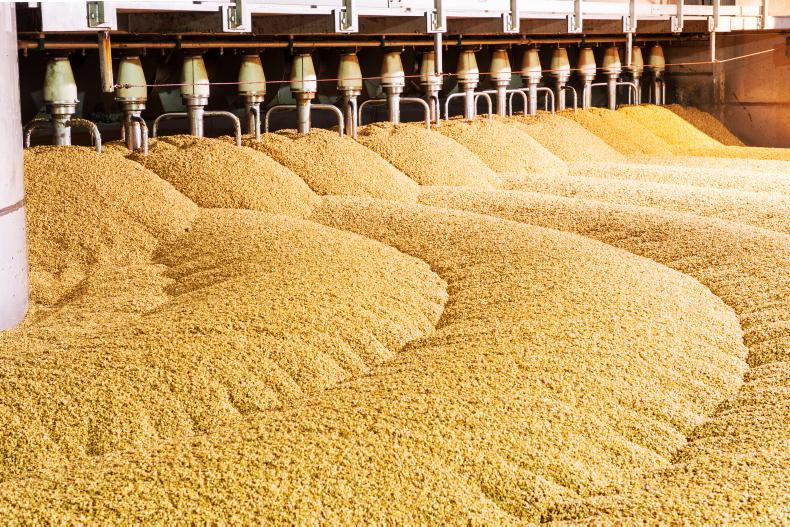
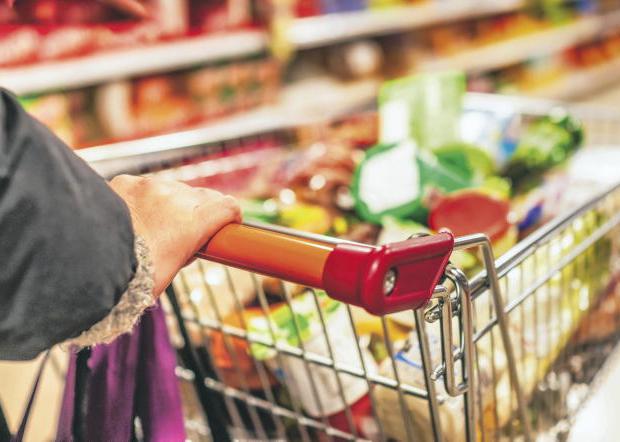
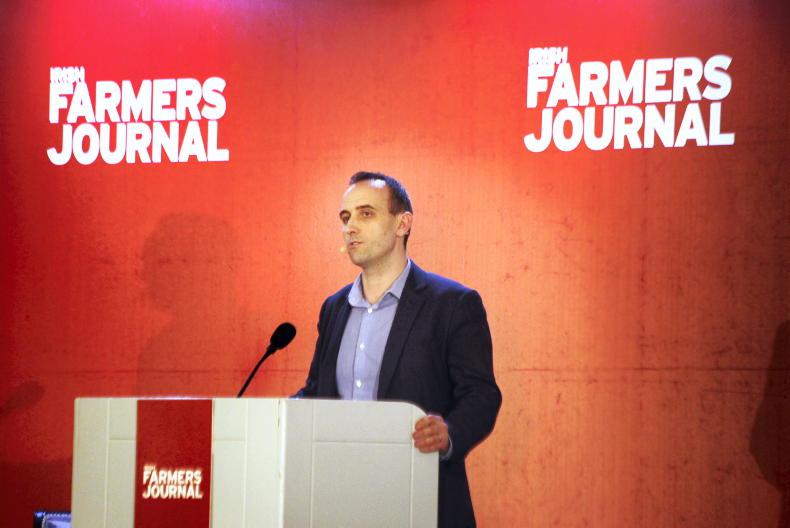
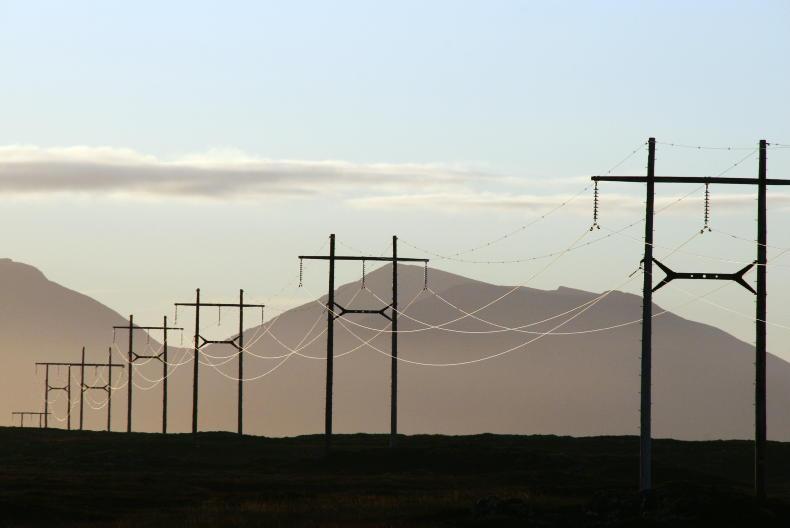
SHARING OPTIONS